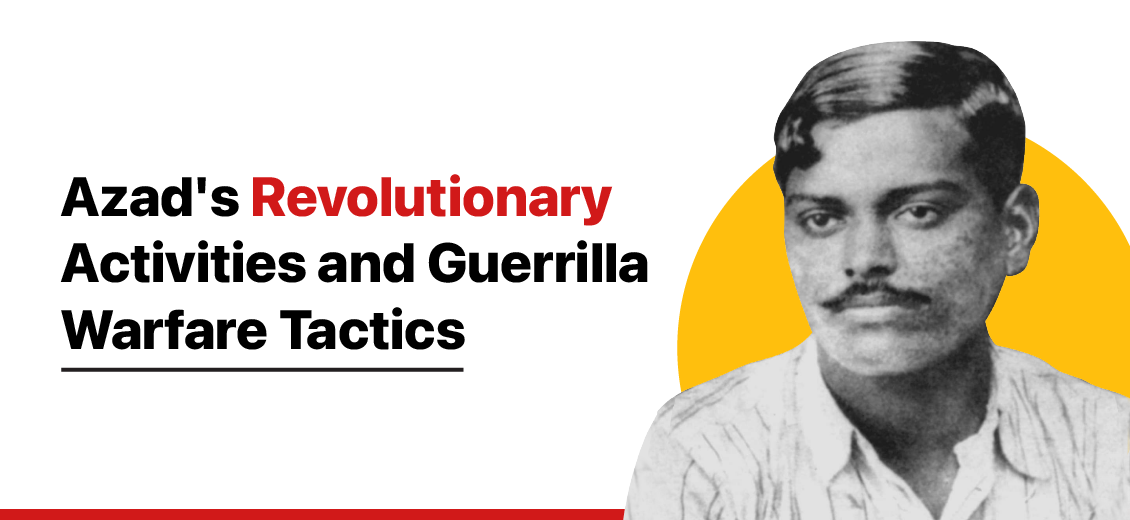Azad's Revolutionary Activities and Guerrilla Warfare Tactics
Blogs Home
- 27 Jul 2023

“If yet your blood does not rage, then it is water that flows through your veins. For what is the flush of youth, if it is not the service to the motherland.”
~Chandra Shekhar Azad
On the occasion of the birth anniversary of this legendary freedom fighter and nationalist born in India, let us take a peek into the history of this whirlwind of revolution. India has been a devoted mother to all her children through all eras of history and as dedicated have been her children, in their faith and yearning for their motherland, in their own ways and capacities. One such revolutionary son, leader and fighter was Chandrashekhar Azad, who embraced martyrdom over slavery, embodying courage at its best.
Introduction to Azad’s Revolutionary Activities
Azad was born to parents Pandit Sitaram Tiwari and Jagrani Devi on 23rd July 1906 in the district of Alirajpur in Madhya Pradesh. During his childhood, he mastered skills like swimming, wrestling, and archery, with the advantage of being surrounded by a Bhil community. After completing his formal primary education in his hometown, Azad completed his higher education at Kashi Vidhyapeeth, Banares. Initially christened as ‘Chandrashekhar Tiwari’, the title ‘Azad’ to his name later symbolizes the yearning for freedom and the metaphor of bravery.
Chandrashekhar pursued his education in the field of Sanskrit at Kashi Vidyapeeth, where he was first introduced to and became passionate about the idea of nationalism. He was immensely triggered by the Jallianwalla Bagh massacre during his early teens. The Non-Cooperation movement led by Mahatma Gandhi also inspired his patriotic sentiments and he later joined the movement actively. After the calling off of the Non-Cooperation movement, his dissatisfaction with Gandhi’s non-violent views made him turn towards a more radical and violent approach towards the British.
Azad's Participation in the Kakori Conspiracy
Azad’s contribution to Kakori Conspiracy was significant and crucial. The Kakori Conspiracy took place as a train loot by Indian revolutionaries of the Hindustan Republican Association (HRA) on 9 August 1925 near Lucknow. They looted the British Government Treasury and killed a train passenger.
Four of the arrested members were hanged, one was imprisoned for life, and others were jailed, Azad being an unapprehended suspect. He was one of the main planners of the train robbery, along with Bismil and Ashfaqulla Khan. He boarded the train at Lucknow and pulled the chain near Kakori to stop it to help his comrades to overpower the guard and other passengers and to loot the cash chest. Azad was also one of the few revolutionaries who managed to escape the police charges and remained underground for several years. He then reorganized the HRA as the Hindustan Socialist Republican Association (HSRA) and continued to lead the revolutionary movement.
The Kakori Conspiracy was an important event in the freedom struggle because it reflected the courage and sacrifice of the revolutionaries who challenged British rule, created a wave of sympathy, and inspired others to join the cause.
Formation and Ideology of the HSRA
Azad established the HSRA in 1928 with the support of Bhagat Singh and other national fighters dissatisfied with the HRA due to its nonviolent methods. The HSRA aimed to eradicate British rule in India and establish a socialist republic by creating a huge movement of workers, peasants, and students to promote revolutionary propaganda,, acquire arms and ammunition for armed rebellion and oppose communalism and spread secularism.
Guerrilla warfare strategy was adopted and implemented by the HSRA on the principles like striking at the weak points of the enemy and avoiding direct confrontation with superior forces, using surprise, speed, and mobility to carry out swift and daring attacks on the enemy, using explosives, firearms, knives, and other weapons to inflict maximum damage and to blend in with the local population for support and enabling quick retreat after each attack to avoid capture and detection by enemies.
Azad's guerrilla warfare principles were based on strong ideas of anti-colonialism, socialism, mass mobilization, and cooperation. His guerrilla warfare examples were the Kakori train robbery, Saunders assassination, Viceroy's train bombing, and the Alfred Park encounter.
Azad recruited, trained and mentored many young revolutionaries, such as Bhagat Singh, Sukhdev, Rajguru, and others. He also coordinated with other nationalist and anti-imp aerialist forces by building strong networks in the country such as with Jayaprakash Narayan and other influential leaders.
Azad's Contribution to Chittagong Armoury Raid
The Chittagong Armoury raid was an impactful attempt by Indian revolutionaries led by Surya Sen to seize weapons from the British armoury in Chittagong in 1930 which was inspired by Easter Rising in Ireland and Communism in Russia. It challenged the British authority and inspired other revolutionaries and showed the collective strength and courage of the Indian youth. Although the raid failed due to a lack of ammunition and betrayal by informers, it exposed the brutality and the repression inflicted by the British regime.
Azad's contribution to the Chittagong Armoury raid was indirect but significant. He was not physically present but was one of the mentors and supporters of Surya Sen. He also provided him with funds, arms, and ammunition for the raid. He had also sent some of his comrades, such as Ananta Singh and Kalpana Dutta, to join Surya Sen's group in Chittagong. Azad maintained contact with Surya Sen and his associates after the raid and tried to rescue them from the British.
Azad's Role in Lahore Conspiracy Case
The Lahore Conspiracy case (1928) was a series of trials against many Indian revolutionaries involved in the failed Ghadar conspiracy in 1915, led by Rash Behari Bose who escaped arrest. Azad’s role in the Lahore conspiracy case was instrumental, being one of the masterminds and participants in the assassination of John Saunders, a British police officer, in Lahore in December 1928. Azad was involved in the escape of Bhagat Singh and other revolutionaries after the killing, along with being one of the planners and supporters of the bombing of the Central Legislative Assembly in Delhi in 1929 by Bhagat Singh and Batukeshwar Dutt. He claimed responsibility for both actions and was declared an absconder by the British authorities and faced trial in absentia in the Lahore conspiracy case.
Comparison of Azad's Approach with Other Freedom Fighters
Chandrashekhar Azad was different in his vision from other freedom fighters in his approach to nationalism and his methods of struggle. He was one of the few leaders who advocated armed struggle against the British, while most of the others followed Gandhi's non-violence and civil disobedience. He wanted to establish a republican and secular state after independence. He did not believe in the two-nation theory or the communal politics of the Muslim League and opposed the partition of India. Azad was also greatly influenced by the Islamic faith and pan-Islamic sentiments and tried to reconcile Islam with modernity and democracy.
Contemporary Relevance of Azad's Revolutionary Ideas
Chandrashekhar Azad's techniques and strategies have ample relevance in present-day India, especially in the context of social movements and protests against injustice and oppression. His courage, commitment, and organizational skills can inspire people to stand up for their rights and dignity. His socialist, secular and humanist vision can also guide people to work for a more inclusive and democratic society.
Azad can be an inspiration to today's generation for his patriotism, bravery, and sacrifice. He was a leader who fought for freedom and justice and gave his life to the nation. He was also a visionary who had a socialist, secular, and humanist outlook. He can motivate people to be fearless and committed to the cause of social change.
Conclusion
At a glance, Chandrashekhar Azad was an impactful and influential revolutionary who fought for India's independence from British rule. He died as a martyr at the age of 24, inspiring millions of Indians to join the freedom struggle and leaving an immortal trace in history.
References:
- Chandrasekhar Azad: Courageous revolutionary - Hindustan Times
- Chandrashekar Azad Biography : His Life Journey, Education And Revolutionary Activities (indiatimes.com)
- https://learn.culturalindia.net/kakori-conspiracy.html
- https://www.indiatoday.in/education-today/gk-current-affairs/story/kakori-conspiracy-334170-2016-08-09
- https://www.britannica.com/topic/guerrilla-warfare
- https://feminisminindia.com/2019/03/15/women-warriors-chittagong-armoury-raid/
Tanmaya Kshirsagar

Tanmaya Kshirsagar is an artist, writer and musician. She works with UN Women as a Youth Ambassador and her work has found a place on platforms like Times of India, Indian Review, Women's Web and Medium to name a few.
Blogs Home



